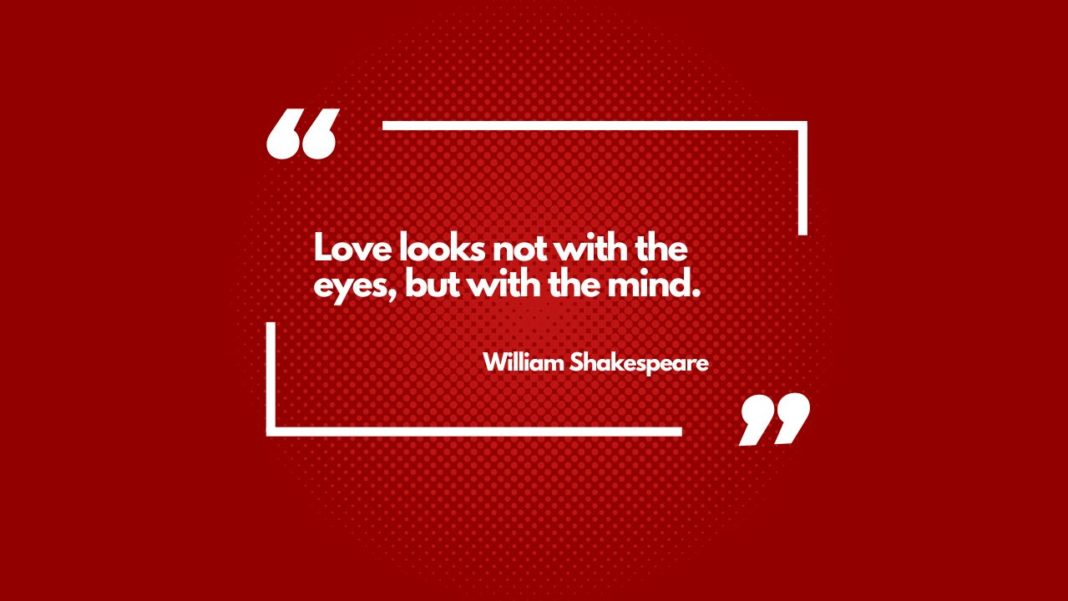In the age of swipes and instant visual judgments, the ancient wisdom of Shakespeare invites a pause: “Love looks not with the eyes, but with the mind.” Today’s dating landscape is saturated with platforms that encourage superficial glances to determine a match, often overshadowing the deeper, more enduring aspects of attraction. This fixation on the external not only misleads but may also shortchange the rich potential of genuine connections.
This article, inspired by Shakespeare’s insightful words, delves into how true compatibility extends far beyond the physical, urging a discovery of the mind and spirit. Here, we explore the realms of mental and emotional connections that often get overshadowed by physical attributes but are ultimately the bedrock of lasting relationships. Through understanding this dynamic, we can uncover a more fulfilling path to love, one that honours the full spectrum of connection and attraction.
True Love: The Power of Perception in Love
Our perceptions shape our reality, especially in the realm of romantic relationships. How we see others and interpret their actions and appearances directly influences how we connect and form bonds. The importance of looking beyond the superficial aspects of a potential partner cannot be overstressed, as enduring relationships often hinge on much deeper connections.
Psychological Insights on Attraction
Attraction, at its core, is not merely a response to visual stimuli but a complex interplay of psychological factors. Research in psychology shows that emotional and intellectual attractions are powerful predictors of long-term relationship success. These elements of attraction include shared interests, communication styles, and emotional responsiveness, which can significantly heighten the perceived physical appeal over time.
The Role of Personality and Values in Lasting Relationships
Personality compatibility and shared values form the backbone of sustainable relationships. Studies consistently find that couples who align on key life values, such as family, ambition, and kindness, are more likely to enjoy higher satisfaction and stability. Additionally, personality traits such as openness to experience and conscientiousness can lead to richer, more engaging interactions that go beyond the initial phases of attraction.
Shakespeare’s Insight on Love
William Shakespeare, writing at the turn of the 17th century, often portrayed love in ways that were remarkably progressive for his time. His plays and sonnets suggested that true love transcends societal expectations and physical boundaries, focusing instead on a deeper, more intellectual connection.
Historical Context
In Elizabethan England, marriages were often arranged for economic or social gain, with romantic love taking a back seat to familial and monetary interests. Shakespeare’s works, however, frequently challenged this norm. His characters often defy parental wishes and social conventions in pursuit of genuine, heartfelt connections, suggesting an early appreciation for the intrinsic value of personal compatibility and emotional bonds.
Analysis of the Quote
The quote “Love looks not with the eyes, but with the mind,” from “A Midsummer Night’s Dream,” emphasises the idea that love is a mental and emotional experience rather than merely a physical or visual one. This perspective invites us to consider love as a recognition of kinship and compatibility that resonates on a mental level, transcending the superficialities that often dominate first impressions.
Connection to Modern Dating
This insight holds significant relevance in today’s world of online dating and virtual connections, where initial interactions are often dominated by images and quick profiles. The convenience of swiping based on attractiveness can overshadow the importance of engaging with a potential partner’s beliefs, interests, and personality. Integrating Shakespeare’s view into modern dating could encourage a shift towards deeper engagements, where conversations and shared experiences become the basis for attraction, fostering connections that are more likely to endure beyond the initial visual appeal.
Cultivating a Mindful Approach to Dating
Adopting a mindful approach to dating can significantly enhance the quality and depth of relationships by focusing on mental and emotional connections. This section offers practical strategies, tools, and benefits to help individuals foster more meaningful interactions in their dating lives.
Strategies for Mindful Dating
Ask Deeper Questions: Move beyond the usual small talk. Ask questions that reveal core values and interests to understand the true nature of the person you’re dating.
Active Listening: Focus fully on your date, paying attention to their words, emotions, and body language. This demonstrates genuine interest and builds a deeper connection.
Be Present: Avoid distractions during dates, such as smartphones. Being fully present encourages a more authentic interaction and a stronger emotional bond.
Mindfulness Tools
Daily Reflections: Regularly take time to reflect on your experiences and feelings about the people you meet. This can help clarify what you truly seek in a partner.
Meditation and Mindfulness Exercises: Engage in meditation to improve your emotional awareness and self-regulation. This practice can help you stay centered and calm, even in the uncertainty of dating.
Journaling: Keep a journal about your dating experiences and emotional responses. Writing down your thoughts can provide insights into your dating patterns and help you focus on what really matters.
Benefits of a Mindful Approach
More Fulfilling Relationships: By focusing on deeper, non-physical traits, relationships can become more enriching and emotionally satisfying.
Increased Self-Awareness: Understanding your own emotions and desires can lead to better choices in partners and a clearer vision of what you want from a relationship.
Resilience in Dating: Mindful dating helps build resilience by reducing anxiety about rejection and the pressure of finding the “perfect” partner, making the dating process more enjoyable and less stressful.
Overcoming the Barriers of Physical Judgment
Physical appearance often dominates initial interactions in dating, but this can create barriers to truly meaningful connections. Understanding and overcoming these biases is crucial for developing deeper relationships.
Challenges of Physical Judgment in Dating
Superficial Decisions: The quick judgment based on physical appearance, often influenced by societal standards of beauty, can overshadow the qualities that truly contribute to a lasting relationship.
Stereotyping: Physical attributes can lead to assumptions about personality or lifestyle that are not only inaccurate but also detrimental to forming genuine connections.
Missed Connections: Focusing primarily on looks might cause individuals to overlook potential partners who could be a great match in terms of values, interests, and personality.
Solutions for Overcoming Physical Biases
Expand Your Criteria: Actively challenge your own criteria for potential partners by focusing on qualities that contribute to deep, lasting connections, such as communication style, sense of humor, and shared goals.
Practice Patience: Give relationships time to develop. Some connections might not be instantly electrifying but can grow stronger through shared experiences and emotional bonding.
Engage in Self-Reflection: Reflect on past relationships and consider the role that physical attraction played in their success or failure. This might help you realign your priorities in dating.
Educate Yourself: Learn about the cognitive biases that influence attraction. Understanding these can help you make more conscious decisions in your dating life.
Seek Deeper Interactions: Prioritise dates that facilitate conversation and emotional connection, such as attending a workshop or a group hike, rather than purely social or aesthetic environments like bars or clubs.
This approach not only enriches your dating experience but also increases the likelihood of finding a truly compatible partner, leading to more satisfying and enduring relationships.
Conclusion
This exploration into the depths of romantic connections, guided by Shakespeare’s wisdom that “Love looks not with the eyes, but with the mind,” has reaffirmed the profound importance of mental and emotional connections in the pursuit of true love. We’ve uncovered that while physical attraction may initially draw individuals together, it is the deeper, intellectual and emotional bonds that sustain and nourish lasting relationships.
Perception’s Power: Our exploration began with understanding how perceptions shape our relationships and the crucial role of looking beyond mere physical appearances.
Shakespeare’s Timeless Insight: We delved into Shakespeare’s era and his progressive views on love, which challenge us to find connections that resonate on a mental level, transcending the superficial.
Mindful Dating Practices: Strategies for cultivating a mindful approach to dating were discussed, emphasising the importance of deeper inquiries, active listening, and presence in nurturing significant connections.
Overcoming Physical Judgments: Finally, we tackled the common biases that favor physical attributes, exploring solutions to foster a more inclusive and reflective approach in our search for companionship.
Reflect on your own dating experiences: what role has physical attraction played, and how often have you felt a deeper connection? As we move forward, we encourage you to embrace a more mindful approach to dating. Challenge your perceptions, focus on emotional and intellectual ties, and create space for relationships that are truly enriching. Let us strive not just to see, but to understand; not just to look, but to connect with the mind and heart.






